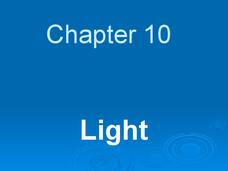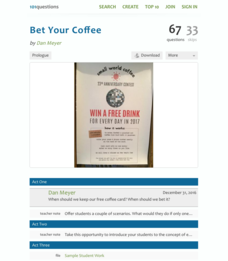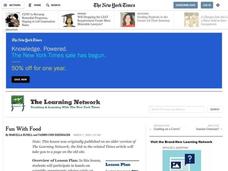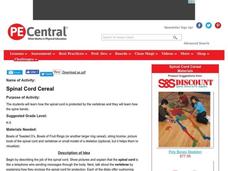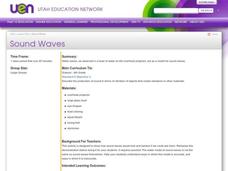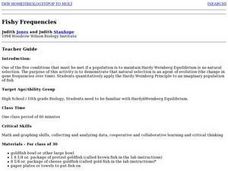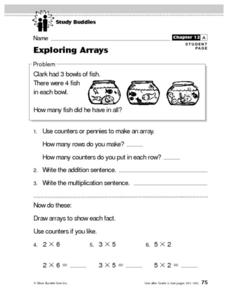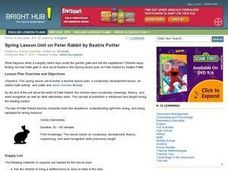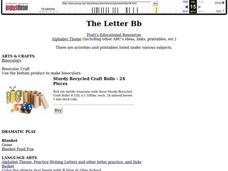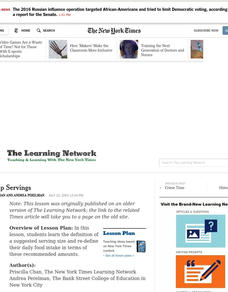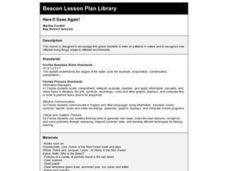Mr. E. Science
Light
Where does bad light end up? In a prism! The presentation covers light, mirrors, lenses, and the structure of the eye. It also provides explanations of reflection, refraction, concave and convex mirrors and lenses, and a comparison of...
101 Questions
Bet Your Coffee
Coffee drinkers, rejoice, here's a chance to win free coffee! Coffee club card holders have the chance to win free coffee every day for a year—but they must enter using their cards good for a free cup. Scholars weigh the chances of...
Curated OER
How to Count Non-Count Nouns
For this noun worksheet, students master the usage of non-count nouns. Students respond to 9 questions using the drop down menu on the interactive website.
Curated OER
A Fish Tale
Students investigate the lives of fish. In this biology lesson plan, students demonstrate how fish cells respond to fresh and salty water, determine the age of a fish and if temperature effects the movement of a fish's operculum (gill...
Curated OER
A Fish Tale
Young scholars conduct an experiment. In this fish lesson plan, students discover how fish cells respond to fresh and salty water and if temperature effect the movement of a fish's gills. Young scholars also identify the...
Curated OER
Birthday Soup
Students utilize the story, "Chicken Soup With Rice, " by Maurice Sendak to compare the number of days in each month, research their birth date and navigate their way through a calendar.
Curated OER
Making Blood
Fifth graders review the components of blood and write four things they have learned. They view a videodisk related to blood components and create a batch of candy "blood" using terminology including platelets, red blood cells, white...
Curated OER
Fun With Food
Students participate in hands-on scientific experiments relying solely on household kitchen materials.
Curated OER
Solar Oven
Sixth graders design two different solar ovens to learn about heat transfer. They investigate the movement of heat between objects by conduction, convection, and radiation. They become aware of things they can't control, like the...
Curated OER
New Forms From Old
Learners examine porcelain objects and see how their original use has been changed to create a new decorative object or an object with a new function. In this porcelain objects lesson plan, students observe the objects and then they will...
Curated OER
Follow the Sun
Students use a simple model of the Earth and Sun as seen from space to explore the sun's apparent movement across the sky over the course of a day and year. They consider the apparent direction of movement and changes in the sun's angle.
Curated OER
Properties of Addition and Subtraction
In this using properties to solve word problems, students find the sums and differences of two-digit numbers using the zero property and the order property of addition to problem solve. Students solve six problems.
Curated OER
Spinal Cord Cereal
Students examine how the spinal cord is protected by the vertebrae and how the spine bends by experimenting with licorice and cereal.
Curated OER
Sound Waves
Students observe how sound waves would look and behave if we could see them. They determine ways the model is accurate and inaccurate based on actual sound waves.
Curated OER
Fishy Frequencies
Tenth graders demonstrate that natural selection is an agent of evolution. They quantitatively apply the Hardy-Weinberg Principle to an imaginary population of fish. They utilize math and graphing skills, collecting and analyzing data,...
Curated OER
Study Buddies: Exploring Arrays
In this math worksheet, young scholars will work with a coach to solve a story problem by making an array. Students will follow a step-by-step process and notes are provided for the coach.
Curated OER
Oxidation: How Can It Be Proved?
Students explore the process of oxidation. In this lesson about oxidation, students observe four different demonstrations. Students watch examples of oxidation in order to understand the process. Students discuss the chemical reactions...
Curated OER
Spring Lesson Unit on Peter Rabbit by Beatrix Potter
Students read about Peter Rabbit. In this lesson, about reading and comprehension, students listen to the story, The Tale of Peter Rabbit, by Beatrix Potter. Students answer questions about the story to determine comprehension. Students...
Curated OER
Mixing Primary Colors
Students demonstrate ways to mix primary colors. In this visual arts activity, students use gelatin and food coloring to create various color mixtures. Students also use tempra paint to mix colors together.
Curated OER
The Letter Bb
Students participate in a variety of activities to practice words with the Bb sound. In this Bb sound lesson, students use craft rolls to create butterflies. Students create a letter book with B words
Curated OER
Pancakes, Pancakes!- Measuring
Learners estimate measurements in real world problem situations. In this estimation lesson plan, students read the book Pancakes, Pancakes and estimate how many cups equal a pint, quart, and gallon. Learners test their estimations by...
Curated OER
Sizing Up Servings
Students learn the definition of a suggested serving size and re-define their daily food intake in terms of these recommended amounts.
Curated OER
Here It Goes Again!
First graders work on patterns in nature and to recognize how different living things adapt to different environments such as the rain forest.
Other popular searches
- Bowling for Columbine
- Math Bowling
- Bowling Pins
- Bowling Skills
- Bowling Dust
- Bowling Scoring
- Bowling Techniques
- Bowling Alone
- Basic Skills in Bowling
- Bowling Activity
- Bowling Bingo
- Bowling Scores


